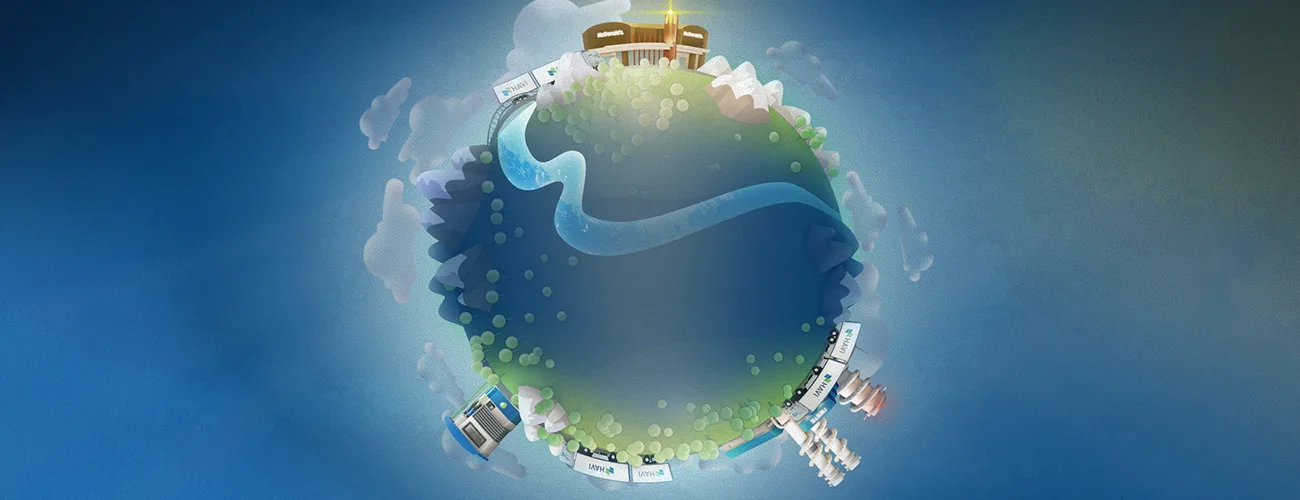
Circular economy
9 minute read
Turning fries into miles – how McDonald’s, Neste, and HAVI create a circular economy that uses cooking oil to fuel logistics
The pioneering partnership between Neste, McDonald’s Netherlands, and HAVI does more than cut fast food’s carbon emissions. It proves that by scrutinizing your company’s sustainability practices, you can reveal hidden ways to future-proof your business through circularity.
Every day, McDonald’s serves fries, hamburgers, and Happy Meals to a multitude of customers. Many of them are unaware that behind the food counters and drive-through windows a streamlined logistics operation ensures that each restaurant receives the supplies, and ingredients they need to prepare meals for their guests. Besides that, with production and food preparation comes some food waste, packaging waste and used cooking oil that needs to be picked up and processed.
Someone who does think about these processes a lot is Antti Koivisto, Head of Service Development within Renewable Road Transportation at Neste. “We buy used cooking oil as feedstock for renewable diesel, and we realized that there are potential suppliers who could actually buy [the diesel] back as a product.”
Approximately 80% of Neste’s feedstock for the production of renewable products comes from waste and residues, and a part of that is used cooking oil. Wouldn’t it be a great example of circularity to find a partner willing to work with Neste to recycle the partner’s own cooking oil and buy back the fuel produced from this oil?
Finding such a partner turned out to be a lot easier than Koivisto expected. “I started exploring the issue, and, after a few discussions, I heard from a colleague that McDonald’s Netherlands had already been in contact with them.” Without knowing about Koivisto’s search, McDonald’s Netherlands and their supply chain partner HAVI had approached the Neste refinery in Rotterdam to set up exactly this type of collaboration.
Aiming for a more sustainable future
Floor Uitterhoeve is Sustainability Manager at McDonald’s Netherlands, and an expert on the ways the company is reducing their carbon emissions.
“We looked at all the different ways in which we could reduce our climate impact,” she says, “and we figured that, even though it's not the biggest impact on our carbon footprint, the way we organize our logistics is something we have a lot of influence over. In addition to reducing climate impact, green logistics would also help to reduce air pollution, which is of increasing concern in Dutch urban areas.”
At a global level, McDonald’s has set Science Based Targets to reduce its climate impact. “One climate goal is focused on our supply chain, so the climate impact related to all the food and packaging we source,” explains Uitterhoeve. “The climate goal for the supply chain is a reduction of emissions intensity of 31% between 2015 and 2030. The other goal is focused on reducing the carbon emissions from our restaurant operations by 36% in that same time period.”
These goals were set in 2018, and with 2030 only 12 years away, every little bit counted. McDonald’s scrutinized every aspect of the business to find ways to reduce their climate impact, and one of these areas was logistics.
Closing the loop
The circular economy involves thinking about waste as a resource, to keep materials in the production loop. For example, by collaborating with fashion brands to encourage people to donate their clothes rather than throwing them away, the city of New York collected 583 tonnes of used clothing in 2019. These can be resold, reworn, or recycled, and overall contribute to a decrease in the need for new source materials.
But the circular economy is about a lot more than recycling household waste. At a meeting hosted by National Geographic in February 2020, Andrew Morlet, CEO of the Ellen MacArthur Foundation, said: “We need to have industry stepping up and actually contributing to the creation of that infrastructure so that these systems can work.”
Repurposing waste from one industry can often create products for a second industry. This creates a circular economy. This can happen on a global scale, or – as the collaboration between McDonald’s, Neste, and HAVI shows – the circle can be very small and efficient.
In the Netherlands, McDonald’s works with logistics partner HAVI for all stock and waste transport to and from the restaurants. HAVI’s Sustainability lead for the Netherlands Anne-Marie Verouden points out: “We at HAVI have committed to drastically cutting our carbon emission from our operations by 40% per metric ton of goods delivered by 2030. The existing partnership with McDonald’s will play a big role in achieving that goal.”
Reinforcing the partnership, Jeroen Dekkers, Head of Supply Chain, Quality and Sustainability at McDonald’s elaborates: “With HAVI we developed a roadmap to see what steps we could take to reduce our carbon emissions from the logistics side and make our logistics more future-proof.” They left no stone unturned, looking into things like more sustainable fuel, more efficient route planning – and finding better ways to deliver food into the historic city centre of Amsterdam by working with storage hubs around the city perimeter.
Many small steps would bring McDonald’s Netherlands closer to its sustainability goals, but Dekkers mentions that there was one key insight that brought them to Neste.
“If we see the use of renewable diesel as part of this integrated logistics sustainability roadmap, should we not link this with another piece of work that we’ve been doing for years, namely selling our used cooking oil to a renewable diesel plant.”
A different way of thinking
To make such a collaboration work, all partners need to place the same value on sustainability. HAVI, McDonald’s Netherlands, and Neste all had their own sustainability goals that perfectly matched what they wanted to achieve together, so they were all motivated to make the changes required to put the plan into action.
For McDonald’s Netherlands, that change involved rethinking the way they categorised the company’s sustainable practices, and Floor Uitterhoeve excitedly describes what they did: “What's interesting is that we made a link between two different sustainability pillars. We used to think of sustainable logistics as one pillar, and recycling used cooking oil as part of another pillar with different teams and different budgets. But if you make links across these pillars, you can have much more impact.”
That realization led McDonald’s Netherlands to rethink the way it was handling both their used cooking oil waste stream and their logistics. A quick calculation revealed that the amount of cooking oil that was used in their restaurants was enough to produce the equivalent amount of renewable diesel to fuel the trucks that supply the restaurants. Rather than selling the used oil, why not find a company that could directly convert it to fuel for the trucks? With the involvement of Neste, the circle was complete.
Setting up a new collaboration wasn’t without challenges. “It’s been a learning journey for all of us,” chuckles Koivisto, as he recalls having to take into account each company’s needs and motivations. Branding and operational models of different organizations are not easily linked, and the refining, restaurant, and logistics industries all speak their own languages. For example, 1.4 million liters of used cooking oil is an enormous amount for a restaurant but little for a refinery. “This just shows the complexity of how these new models are being adopted,” says Koivisto.
Once the agreement was completed, the process was put into action. “HAVI’s waste and recycling business unit picks up the used cooking oil from McDonald’s restaurants across The Netherlands and brings it to the Neste refinery in Rotterdam, where it enters the production chain to be converted into Neste MY Renewable Diesel,” Anne-Marie Verouden explains. “HAVI then buys back an equivalent amount of renewable diesel to fuel their trucks for delivery of stock to McDonald’s restaurants, where the cycle starts again.”
Neste MY Renewable Diesel is an advanced biofuel, which can be used in conventional vehicle fuel systems without the need for modification or additional maintenance. The carefully tested, high quality biodiesel can help its users reduce greenhouse gas emissions by up to 90% over the life cycle of the fuel*.
Lessons learned from creating a circular solution
A small circular economy like this might seem like a drop in the ocean, but its value isn’t just measured in the amount of reused cooking oil or carbon emission reduction.
For Neste, the partnership with HAVI and McDonald’s Netherlands acts as a showcase to demonstrate what’s possible when it comes to sustainable practices. “The beauty is that it shows stakeholders a concrete example of the circular economic movement,” says Koivisto.
Likewise, with 1.4 million liters of reused cooking oil per year, the fuel conversion for the McDonald’s logistics operation in The Netherlands only contributes to a small part of their overall sustainability goals, but it makes for an important step in the way that the company thinks about its processes. “I think so far we've considered our supply chain to end at a restaurant level,” says Jeroen Dekkers. Because they thought about sustainability in terms of pillars, waste recycling and supply were considered as two separate processes. “We have now learned that actually, we're in the middle of the supply chain.”
One of the unique aspects of this collaboration is that everything takes place within a closed loop and with only a few links in the chain. It’s the ultimate example of a circular economy. “We have more direct contact with the parties in the chain,” says Dekkers. “So, we feel like partners more than just buyers and sellers to each other — like in all long-lasting partnerships in which we encourage each other to improve and innovate.”
Verouden shares another exciting collaboration well underway at HAVI: with their strategic partner Scania, HAVI will introduce hybrid electric trucks fueled by Neste’s product in the next few months.
Even at a personal level, Antti Koivisto has enjoyed the new challenges that this collaboration brought. “I’m an engineer by background so I love doing new things,” he says. “This is a new way of working, and it’s very inspiring. I want to show through my work how innovative thinking can bring concrete positive impact.”
He would also love to see more of such projects in the future and encourages other organisations to find circular solutions – either with Neste or other partners. Even though it can be challenging to work across different organizational structures and ensure that there is a benefit for all partners in the chain, Koivisto believes that such small-scale circular economies go a long way in demonstrating how sustainable practices can be achieved effectively.
“I think that's what I'm looking for in sustainability: more of these unconventional partnerships that show that things are possible.”
*) The method used to calculate life cycle emissions and emission reduction complies with the EU Renewable Energy Directive (2009/28/EC).
Neste MY Renewable Diesel™
Neste MY Renewable Diesel™ reduces GHG emissions up to 90% compared to fossil diesel. The fuel is an existing solution for reducing the climate impact of road transport - today.




